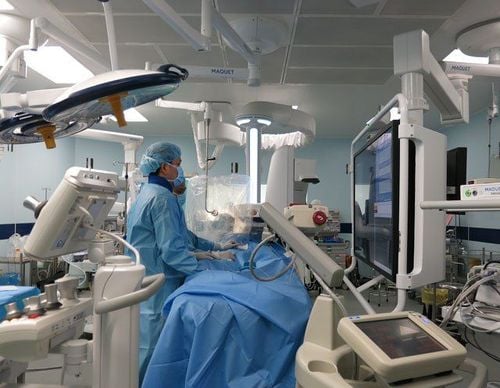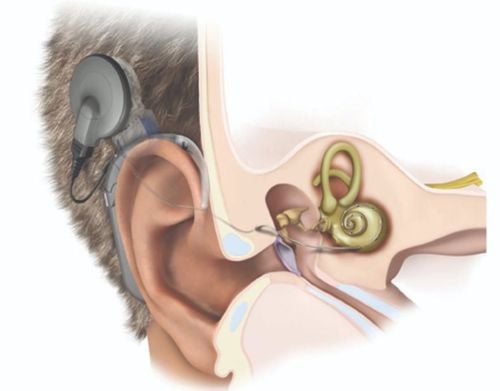This is an automatically translated article.
The stapes is one of the 3 bones that make up the middle ear, an injury to the stapes affects the conduction of sound into the inner ear, causing hearing loss. In cases where the stapes are stiff, surgical replacement of the stapes is required to restore hearing.1. What is stapes replacement surgery?
The stirrup bone is the lightest bone in the body and is shaped like a stirrup. In the middle ear, there are 3 bones, which are the hammer, incus and stirrup, they participate in conducting sound into the inner ear, this mechanism helps us to hear.When the stapes is stiff, it reduces or cannot conduct sound into the inner ear, causing hearing loss or deafness.
The goal of stapes replacement surgery is to reconstruct sound conduction through the scapula to restore hearing. The replacement of the stirrup bone can be with a variety of materials.
During surgery, depending on the type of injury, it is possible to take the entire stapes base or only a part of the pedal to be replaced with other materials.
2. Indications and contraindications for stapes replacement surgery?
Indications for performing stapes replacement surgery include:Patients are diagnosed with conductive or mixed deafness due to fixed stapes. In case the patient has binaural hearing loss due to a problem from the stapes, the worse ear is indicated for surgery first, this is a subjective sign that mainly depends on the patient's perception. For children, which ear surgery is indicated first depends on the audiogram, surgery can be performed before school age to avoid having to wear the device when starting school. are adults and have the right to decide for themselves whether to have surgery or not. Air-bone gap (distance between air line and bone line) 30dB. The patient must be in good condition, without any medical disease affecting the surgery, especially if general anesthesia is planned, the cochlea is not affected, indicating that the speech discrimination threshold is still good.

Thính giác kém do xương bàn đạp gặp vấn đề
Poor health, medical disease that affects surgery, contraindications to the use of anesthesia. Patients with balance disorders, such as in Ménière's syndrome or hearing loss, fluctuate at times of increase and decrease. Having a stable otitis media that has not been treated. Narrow Rinner space (method comparing airway conduction with bone conduction). The surgical ear is the patient's only ear. The lesion affected the cochlea, indicating poor speech discrimination threshold. The patient refused to perform surgery.
3. Steps to perform stapes surgery
3.1. Prepare the patient before surgery
Patients or family members need to be thoroughly explained about the benefits as well as limitations and risks of stapes replacement surgery. Cut clean hair above and behind the earlobe 2 cm from the hairline. Examining and testing adequate measures to diagnose, monitor response after surgery such as chest X-ray, CT scan of temporal bone to detect fibrous fossa, rule out malformations of bones, routine testing; monophonic and convex audiometry. Was examined and assessed to have no nasopharyngeal disease.3.2. Procedure for performing surgery
Step 1: The patient's position is supine, the head is turned to one side without surgery, and the ear to be intervened is up. Step 2: Disinfect the ear canal and surgical ear area with povidine solution. Step 3: Anesthesia, choose the appropriate method, in stapes replacement surgery can be general anesthesia and additional anesthesia of the ear canal or pre-anesthesia and local anesthesia depending on the experience and choice of surgery tablets and depending on the individual patient. Step 4: Carry out surgery Using an ordinary otoscope or an otoscope with grooves and self-braking, use a knife to cut the skin behind the ear canal about 6 - 2 hours, about 7mm from the eardrum. Then make 2 parallel incisions from this incision to about 4 mm from the eardrum. Next, dissect the skin flap of the ear canal and the tympanic membrane, and the tympanic cord is pulled forward. Using a drill to open the posterior ulnar bone, clearly expose the tendons of the stapes, the joints of the anvil and stapes, and the sole of the stapes. Pay attention to clearly determine whether the VII nerve is exposed or partially obscured to avoid facial paralysis. Make a hole in the base of the stapes, use a sharp stick to peel off the edge around the base of the stapes, then cut the stapes tendon and remove the cleavage joint. Move the entire stirrup, then remove the entire stirrup. This stage should be carried out very carefully, to avoid the risk of falling inwards of the stapes, causing profound deafness and dizziness. Remove the meniscus from the cap of the ear cup or a piece of the dorsum of the hand approximately 5 x 5 mm in size. Then thread the prepared piece of vein or meniscus to cover the oval window so as to seal the edges of the oval window and cover the second segment of the Fallop canal. Place the prepared guide post and recheck the guide post, the mobility of the scapula system. Step 5: Close the incision and check after surgery When performing and checking the movement of the sub-skeletal system, the tympanic membrane and skin flap of the ear canal are placed back. At this time, it is possible to test hearing by whispering if the patient is operated under anesthesia, the patient will show a distinct hearing perception. Insert an antibiotic oil wick into the ear canal. Lightly compress the incision.
Tiến hành phẫu thuật thay thế xương bàn đạp
3.3. Monitor for possible adverse events
Monitor the whole situation to detect complications caused by insensitivity measures early. Facial paralysis due to nerve contact VII: During surgery, it is necessary to observe the VII nerve to avoid damage to the VII nerve, if the VII nerve is exposed and partially covers the base of the stapes, it is possible to gently lift the VII nerve out. pedals and continue surgery. If paralysis VII after surgery needs to be treated like paralysis VII due to trauma. Slip-on soleplate: Avoid this by always remembering to open a small notch in the soleplate before removing the ligaments around the sole. Peripheral fluid leak: Temporarily seal with a piece of muscle fascia, and then, while aspirating, place a piece of meniscus covering the base of the stapes and quickly place the guide post. Dizziness during surgery: When removing the pedal base, be careful, if it is rough, it can cause dizziness. Care should be taken to monitor the patient during the procedure. Tear eardrum: Remove a piece of existing meniscus to reconstruct the eardrum. Unusually deep and narrow oval window: Corrected by opening in pedal base. In addition, the patient should be instructed on how to take care to avoid injury to the incision and use the medication prescribed by the doctor.Stavebone replacement surgery can be performed from 7 years of age and older if there are no contraindications. Therefore, when you encounter some ear problems, you need to visit a medical facility for early diagnosis and treatment.
Currently, the ENT specialist - Vinmec International General Hospital is one of the prestigious addresses, trusted by a large number of customers in examining and treating common ENT diseases, tumors. head, face, neck, congenital malformations in the ENT region by common surgical methods such as surgery, microscopic or endoscopic tympanic patch, fistula removal, Bondy surgery, nasopharyngeal aerosol, injection Not only has a system of modern facilities and equipment, Vinmec is also a place to gather a team of experienced doctors and nurses who will greatly assist in the diagnosis. diagnose and detect early signs of abnormality of the patient's body. In particular, with a space designed according to 5-star hotel standards, Vinmec guarantees to bring patients the most comfort, friendliness and peace of mind during the examination and treatment at the Hospital.
Please dial HOTLINE for more information or register for an appointment HERE. Download MyVinmec app to make appointments faster and to manage your bookings easily.













